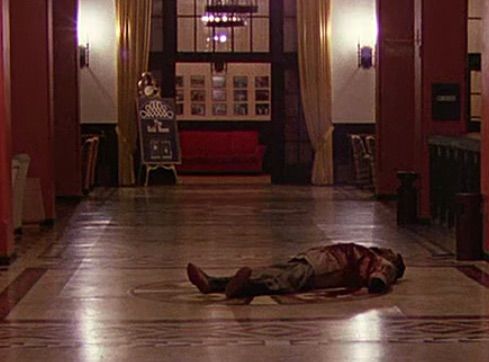Track(steadicam):
A tracking shot is where the camera follows the character(s) while they traverse the setting, tracking shots can either be made with a Steadicam or without. In older movies you would probably tend to see more handheld tracking shots – this is because they had to use a track around the set for the camera setup, and since a tracking shot can follow the characters from behind the viewer would see the track the camera has yet to go on, this would tear the verisimilitude and make the movie objectively subordinate to others from a technical standpoint. An example of a tracking shot that doesn’t use a steadicam would be a scene in Pulp Fiction(1994, Quentin Tarantino) where the camera follows a character walking through a broken barb wire fence. The inevitable shaking of the camera can actually work in the filmmakers favour as the shaking can actually convey an ominous mood, this may be because the observer could relate the shaking to when they themselves may shake when they’re feeling anxious/nervous – so when they see this happening to the camera it almost universalises that emotion with the audience and the character which makes them feel further connected and therefore easier to follow (story wise)

Pan:
A shot which uses a pan is where the camera moves like how your vision shifts focus when you move your eyes. In simpler terms a pan moves the camera fairly quickly along either a vertical or horizontal plain in order to show the audience what: the character is looking at, the characters are talking about/referencing or what the character should’ve seen/noticed. A pan shot can also be used to simply follow something across the screen, for example in The Shining (1980, Kubrick) a pan shot is used to follow Johnny’s axe while he swings it at the door. By doing this Kubrick emphasised the force in which Jack is using to break down the door to then murder his family, showing this conveyed to the audience that the Jack they were introduced to at the beginning of the film is gone now and this version of him is not going to hesitate to kill anyone regardless of who they are – this idea was in fact demonstrated a bit prior to the scene where Mr Halloran was murdered by him for standing in his path.


Rack Focus:
Rack focus is when the focus is sharply changed – so lets say the character is in the background of a shot and there’s something the director wants the audience to notice, rack focus will then be used to focus more on the object (which is closer to the camera). This can be very dramatic and adds a lot of tension when it’s done right and saved for the right time, an example would be in Breaking Bad(2008, Gilligan) where Jesse is forced to shoot and kill someone(Gale) because otherwise he’ll be paranoid that someone will come after him and kill him. So while Jesse is facing a Self vs. man conflict silently the camera uses rack focus to shift the focus from Jesse’s distraught face, to the gun which he’s holding. By doing this Gilligan prepared the viewers for another untimely death in the show, he most likely did this because the previous episodes in the show built on his(Gale’s) character so instead of killing his character off, Gilligan made an effort to possibly just remind the viewers that Gale is dead for certain and he’s not coming back, by doing this obvious but secrete emphasis Gilligan builds more upon the already brilliant verisimilitude

